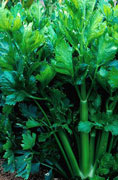


Home
Flowers &
Indoor Plants
Fruits & Nuts
Ornamentals
Vegetables
Special Topics
Resources
Glossary

|
Celery Apium graveolens var. dulce (ay-pee-um grah-vee-ol-ens) 

|
 |
What about it? Celery is a member of the Parsley family along with its cousins, the carrot and the parsnip. Celery is not an easy crop to grow, but if you are diligent you will be successful! What is it used for? The edible portion of the plant is the leaf stalks, or petioles. The leaf blades are also edible. Where does it grow? How do we grow it? Celery needs a long growing season of 120 to 150 days, and mild temperatures. Cool nights, below 55 degrees F, will promote premature seeding, however. Plant celery in rich soil with adequate moisture. Celery has a shallow root system and cannot dig as deep as other garden plants for their necessary nutrients. Be sure to give your plants plenty of water and soil nutrients so they don't have to work so hard. Some celery varieties require blanching, so read the seed package to check requirements in advance. What are its primary problems? Aphids and carrot pests can be bothersome to celery. How do we propagate it? Begin your celery plants indoors about 3 months before you intend to place them outside. Celery seeds don't keep well so be sure to buy a fresh pack of seeds each year. Soaking the seeds in water before planting them in starter pots will lessen the germination period. Plant transplants 8 inches apart in rows that are 10 inches apart. You may want to d i rect-seed your second crop of celery, but these will need to be thinned when they get to be 5 inches tall How do we harvest and store it? Harvest when leaf stalks are succulent and the bunch is ideally 34 inches in diameter. Cut celery at the base of the stalks. Keep celery cool and moist. Celery should keep for several weeks if stored at very cool temperatures. For short storage periods you can place the celery in water to enable water uptake that will keep the celery crisp.
© Copyright, Department of Horticulture, Cornell University. |